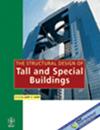Seismic analysis and connection optimization of the side column on modular prefabricated four‐sided connected composite shear wall
IF 1.3
3区 工程技术
Q3 CONSTRUCTION & BUILDING TECHNOLOGY
引用次数: 0
Abstract
A modular prefabricated four‐side connected composite (MPFC) shear wall that consists of a composite shear wall modular (CSWM) and steel frame boundary elements is proposed. First, the finite element model (FEM) of the MPFC shear wall, which considers a plastic‐damage constitutive model of both concrete and steel materials, is established based on the finite‐element software ABAQUS. Second, the FEM accuracy of the MPFC shear wall is verified by the experimental results of a modular prefabricated two‐sided connected buckling‐restrained (MTB) steel plate shear wall. Third, the seismic performance of the MPFC shear wall is investigated based on the verified FEM. The connection between the CSWM and side column is optimized. Finally, the initial stiffness calculation formula of the MPFC shear wall that considers the impact of that the thickness ratio between the connection steel plate (CSP) and inner steel plate (ISP) is deduced. The results show that the peak bearing capacity, initial stiffness, total energy, and total strain energy of the MPFC shear wall increased by 42.47%, 44.81%, 113.24%, and 58.97%, respectively, compared with those of the MTB steel plate shear wall. The compressive corner damage of the reinforcement concrete faceplate (RCF) of the MPFC shear wall with a side column and CSWM is connected by a middle steel plate is effectively improved. Compared with those of the MPFC shear wall in which the side column and CSWM are connected by bolts, the shearing force, axial force, and bending moment of the side column of the MPFC shear wall in which the side column and CSWM are connected by the middle steel plate are notably decreased by 25.32%, 26.08%, and 39.51%, respectively. The FEM results are compared with the formula calculation results to establish its accuracy in calculating the initial stiffness of the MPFC shear wall.组合式预制四边连接组合剪力墙侧柱抗震分析及连接优化
提出了一种由组合剪力墙模块(CSWM)和钢框架边界单元组成的模块化预制四边连接复合材料(MPFC)剪力墙。首先,基于有限元软件ABAQUS建立了MPFC剪力墙的有限元模型,该模型考虑了混凝土和钢材的塑性损伤本构模型。其次,通过模块化预制双面连接屈曲约束(MTB)钢板剪力墙的试验结果验证了MPFC剪力墙的有限元精度。第三,在有限元验证的基础上,对MPFC剪力墙的抗震性能进行了研究。优化了CSWM与侧柱之间的连接。最后,推导了考虑连接钢板(CSP)与内板(ISP)厚度比影响的MPFC剪力墙初始刚度计算公式。结果表明,与MTB钢板剪力墙相比,MPFC剪力墙的峰值承载力、初始刚度、总能量和总应变能分别提高了42.47%、44.81%、113.24%和58.97%。有效地改善了带有侧柱和中间钢板连接CSWM的MPFC剪力墙钢筋混凝土面板的压角损伤。与侧柱和CSWM采用螺栓连接的MPFC剪力墙相比,侧柱与CSWM采用中间钢板连接的MPVC剪力墙的侧柱剪力、轴向力和弯矩分别显著降低了25.32%、26.08%和39.51%。将有限元计算结果与公式计算结果进行了比较,以确定其在MPFC剪力墙初始刚度计算中的准确性。
本文章由计算机程序翻译,如有差异,请以英文原文为准。
求助全文
约1分钟内获得全文
求助全文
来源期刊
CiteScore
5.30
自引率
4.20%
发文量
83
审稿时长
6-12 weeks
期刊介绍:
The Structural Design of Tall and Special Buildings provides structural engineers and contractors with a detailed written presentation of innovative structural engineering and construction practices for tall and special buildings. It also presents applied research on new materials or analysis methods that can directly benefit structural engineers involved in the design of tall and special buildings. The editor''s policy is to maintain a reasonable balance between papers from design engineers and from research workers so that the Journal will be useful to both groups. The problems in this field and their solutions are international in character and require a knowledge of several traditional disciplines and the Journal will reflect this.
The main subject of the Journal is the structural design and construction of tall and special buildings. The basic definition of a tall building, in the context of the Journal audience, is a structure that is equal to or greater than 50 meters (165 feet) in height, or 14 stories or greater. A special building is one with unique architectural or structural characteristics.
However, manuscripts dealing with chimneys, water towers, silos, cooling towers, and pools will generally not be considered for review. The journal will present papers on new innovative structural systems, materials and methods of analysis.

 求助内容:
求助内容: 应助结果提醒方式:
应助结果提醒方式:


